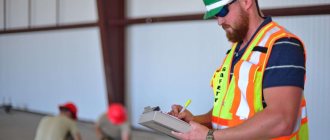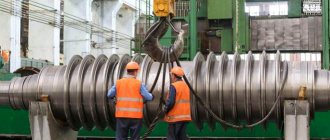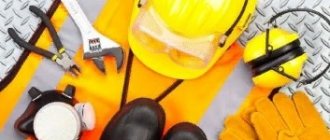A safety, health and labor standards engineer is one of the key specialists of the enterprise. He is responsible for compliance with the rules of organizing the work process, ensuring the preservation of the life and health of employees.
Professionals who have received specialized education do everything possible to eliminate the likelihood of accidents at work and reduce the risks of slowing down work at the site. There are special requirements for the qualifications of occupational safety engineers, because these people instruct workers who come into contact with dangerous devices and perform technically complex tasks.
Who is a Health and Safety Officer?
This is an employee who monitors compliance with occupational safety and health (OHS) requirements and is responsible for preventing accidents and occupational diseases at the enterprise.
In what case should an organization have such a specialist on its staff? If the number of employees exceeds 50 people (Article 217 of the Labor Code of the Russian Federation, letter of the Ministry of Labor dated June 10, 2016 No. 15-2/OOG-2136).
Complete training and obtain a certificate as an occupational safety specialist
With a smaller number of personnel, the director of an organization or individual entrepreneur can take on the functions of a labor protection specialist, entrust them to another employee, or use the services of third-party providers.
Salary level in the field of labor protection
A specialist who has received the necessary education, but does not have a category, can count on a salary of 15-25 thousand rubles. His salary will increase as he gains experience and improves his qualifications. On average, safety and health engineers receive 40-70 thousand rubles. The salary of profile managers starts from 100 thousand rubles and directly depends on the type of organization.
A labor protection engineer is a responsible and in-demand specialty. The well-being of employees of large enterprises, the profits of companies, and the speed of their development depend on these people. If you have the necessary knowledge and required skills, an expert can count on realizing his talents and climbing the career ladder.
https://youtu.be/txZwchj03oA
What does a labor safety engineer do?
REFERENCE. Today, the term “engineer” is not used for occupational health and safety (OHS) positions. Another name used is “occupational safety specialist.”
Such an employee organizes briefings, monitors conditions in the workplace, investigates work-related injuries, monitors changes in labor legislation, participates in conducting a special assessment of working conditions (see “SOUT (Special Assessment of Working Conditions)”) and much more.
Prepare documents on labor protection in a special service
OT engineer - job description
The job responsibilities of a labor safety and regulation engineer are established by the instructions. They may differ depending on the type of professional, his tasks and specialization. Their implementation is aimed at preserving the life and health of the company’s employees, maintaining the company’s commercial interests and its work within the framework of existing legislation.
Responsibilities of a representative of the profession
People who have trained as a safety or health engineer are able to occupy different positions and take part in all stages of the production process. Some become experts in assessing the safety of environmental conditions and operating equipment. Others give lectures on labor protection at enterprises or in educational centers. Experienced professionals draw up work schedules, job descriptions, and conduct certifications of lower-ranking employees. There are also universal specialists who perform all of the above functions.
The labor standards and safety engineer must:
- be able to calculate performance indicators that will provide the company with the required speed of work and will not have a negative impact on the well-being of employees;
- establish optimal technical standards taking into account the specifics of the field and monitor their compliance;
- assess working conditions and, if necessary, make adjustments to them to ensure comfortable living conditions for the staff;
- a safety engineer either conducts lectures and seminars in his field, or trains work group foremen to do so;
- Often such employees are responsible for compiling lists of persons included in special categories (for example, those associated with hazardous production) - they monitor their workload level, schedule, and payroll features.
Also, the responsibilities of a labor protection engineer include constantly improving their level of knowledge and qualifications. Technical progress leads to the emergence of new methods in production and the introduction of modern equipment. A professional in his field must take these points into account, making timely adjustments to instructions, manuals, schedules and plans.
Goals and objectives of the specialist
The labor standards and safety engineer assumes great responsibility to the employees of the reporting facility and its owners. Neglect of responsibilities or a low level of knowledge on a specific issue can lead to a production disaster. This is fraught with human casualties and losses for the enterprise.
The work of a labor safety and regulation engineer is aimed at:
- prevention of accidents and dangerous situations;
- control over compliance with technical, moral and legal standards in production;
- increasing the profitability of the enterprise, reducing its costs and preventing financial losses;
- timely detection of breakdowns, technical imperfections, dangerous working conditions;
- prevention of the development of occupational diseases among employees;
- providing all departments of the enterprise with information on labor issues, taking into account the specifics of the industry or department;
- maintaining the necessary documentation and drawing up reports on the work done, interacting with inspection authorities.
Not all key skills in the field of labor protection can be mastered by receiving education in the chosen profile. You also need to understand the specifics of a particular area, be well versed in the psychology of relationships between people, and the peculiarities of organizing the work process. Career guidance will help a job seeker to soberly assess his capabilities and make sure that the decision he has made is correct.
Requirements for a labor protection specialist
A professional standard has been developed for specialists in the field of occupational safety (approved by order of the Ministry of Labor dated 04.08.14 No. 5245n). It provides for two qualification levels: sixth and seventh (see table).
Table
What are the requirements for occupational safety specialists established by the professional standard?
| Skill level | ||
| 6 | 7 | |
| What positions can you hold? | OT Specialist | Head of OT service or OT specialist |
| Functions | Implement and ensure the functioning of the occupational safety management system and monitor it | Plan, develop and improve the occupational safety management system |
| Education and Training Requirements | Possible options: | |
| — higher education in the field of “Technosphere Safety” or corresponding specialties in ensuring the safety of production activities; — higher education and additional vocational education (vocational retraining) in the field of occupational safety; — secondary vocational and additional vocational education (vocational retraining) in the field of occupational safety | -higher education in the field of “Technosphere Safety” or corresponding specialties in ensuring industrial safety activities; — higher education and additional vocational education (vocational retraining) in the field of occupational safety | |
| Experience Requirements | If you have a higher education, there are no experience requirements; with secondary vocational education, at least 3 years of experience in the field of occupational safety is required | At least 5 years in the field of occupational safety |
| Conditions for permission to work | If there are hazardous production facilities, it is necessary to undergo training and certification in the field of industrial safety | |
Retrain and improve your skills in the field of labor protection
Who can work as a labor protection specialist?
When hiring a specialist, are employers required to adhere to the qualification requirements set out in the professional standard? Yes, we must. But not always, but only if the same requirements are also established by federal law (Article 195.3 of the Labor Code of the Russian Federation).
For the position of “OHS specialist,” the law establishes one requirement: the presence of appropriate training or experience in this field (Article 217 of the Labor Code of the Russian Federation). This means that only a person whose education or experience meets the criteria of the professional standard can apply for the specified vacancy.
IMPORTANT . If a person does not meet the professional standard, but already holds the position of an occupational health or safety specialist, he cannot be fired. You can only reduce the bonus, send them to advanced training courses, etc. But, if this is a candidate for a position, the employer does not have the right to hire him. This conclusion follows from paragraph 6 of the information of the Ministry of Labor dated 04/05/16 (see “Professional standards: when and how employers should apply them”).
Qualification Requirements
You can often hear questions about whether professional standards should be observed. The answer depends on the specific situation. Let's figure out whether it is necessary to take into account the criteria.
If work is associated with restrictions, compensation and benefits that a person can receive, then education and qualifications must correspond to information from qualification reference books, as well as the professional standard. But the labor code states that it is not always necessary to comply with professional standards. It is mandatory when required by laws or other regulatory documents. If this is not written down, then management can apply the requirements to employees at will.
Where are health and safety specialists trained?
It is good if a person has graduated from a university in the field of “Technosphere Safety” or relevant specialties in ensuring the safety of production activities. This means that he has received the necessary higher specialized education and can start working.
If he has a higher non-core or secondary vocational education, he will have to undergo additional vocational training in the field of occupational safety. According to clause 2.3.6 of the Occupational Safety and Health Training Procedure (approved by Resolution of the Ministry of Labor dated January 13, 2003 No. 1/29), you can improve your qualifications in an educational institution where there are full-time teachers and where occupational safety and health disciplines are taught.
Complete the “Technosphere Safety” course and receive a diploma
How to get occupational safety training
How to undergo professional retraining in labor protection
You need to choose a licensed training center with accreditation from the Ministry of Labor to conduct training for employers and employees on occupational safety issues. Such centers offer retraining programs for both heads of labor protection services and ordinary specialists.
For example, at Kontur.School you can get a diploma in the following areas:
- Technosphere safety for the head of the labor protection service (284 academic hours);
- Occupational Safety and Health. Technosphere safety (256 academic hours).
How to get distance education in occupational safety
Nowadays, distance education has become very popular, and in most cases, the only one available. Therefore, almost every training center has online courses, including OT. Training includes webinars, online tests, feedback from experts, etc. For example, Kontur.School offers various types of training at the School of Occupational Safety and Health. Some webinars can be watched for free.
Interesting Facts
The problem of labor protection was dealt with by the great scientist M.Yu. back in the 17th century. Lomonosov. In his work “The First Foundations of Metallurgy or Mining,” he noted the need for safe organization of work and rest, reliable ground support, comfortable clothing for workers, etc. At the state level, labor safety problems were considered in the mid-19th century. in the following documents: “Regulations on relations between the owners of factory establishments and workers” from 1835 and “Regulations on the prohibition of factory owners from assigning labor to child workers under 12 years of age” from 1845.
At the global level, issues of labor protection began to arise at the beginning of the twentieth century. In 1919, the International Labor Organization was created, which Russia joined later.
Aphorism: Occupational safety and health – is it a science or an art? This is religion. You may not believe in it, but the rituals should be observed.
Pros and cons of the profession of occupational safety engineer
The advantages include demand due to legal requirements. After all, the head of a company with more than 50 employees, regardless of his desire, is obliged to hire an occupational safety specialist. As a result, well-educated professionals compete for decent pay.
Among the disadvantages is a large amount of paperwork: filling out reports, acts, drawing up instructions, etc. Therefore, before becoming a labor protection specialist, you need to determine how suitable this type of work is to a person’s character.
What information must be included in the job description: expert advice
The Labor Code does not have sections devoted to job descriptions. It is believed that this is a local regulatory act of the employer, which stipulates the rights and obligations of employees, qualifications and other requirements for persons who will occupy the position or profession specified in the instructions. It is mandatory to have a job description only for the civil service, but experience has shown that the correct instructions protect both the employer and the employee in court, and a formally drawn up one, including rash obligations, can become an evidence base in criminal prosecution .
Example:
In professional standard No. 524n there is a labor function with code B/01.6 - ensuring control over compliance with labor protection requirements . This means that the occupational safety specialist is obliged to ensure control over compliance with occupational safety requirements in the organization.
At the same time, the professional standard does not require that an occupational safety specialist is obliged to ensure compliance with labor protection requirements at each workplace.
To ensure the safety of workers must:
- the workers themselves
- immediate managers
Therefore, if an employee died because he used a power tool with a broken insulation on the handle, that is, he knew that his behavior could lead to an accident, the fault is not the occupational safety specialist, but the employee himself and poor organization of work.
Remember that just one word in the job description can either emphasize whose fault and under what circumstances the death of the employee occurred, or tell the investigator who is ultimately to blame for what happened. Ensure “compliance control” and “ensure compliance” “control” is missing , but in this situation the occupational safety specialist becomes the culprit that the employee picked up an electric sander one unfortunate day, the cord short-circuited, and the employee was injured. from electric shock and concomitant injury when the grinder falls on a limb.
Therefore, the mechanic’s job description should say “ensure compliance ,” the same phrase should be written in the senior mechanic’s job description, and the safety specialist’s instructions should say “ensure control .
Real story
Quite recently, a group fatal accident occurred in the Moscow region. At the same time, the job description of the head of the labor protection service stated that the employee “is obliged to ensure compliance with labor protection requirements when performing construction and installation work . Now the head of labor protection is being questioned by the investigative committee, and all because he did not pay attention to the slippery wording, which could lead to a real prison term.









